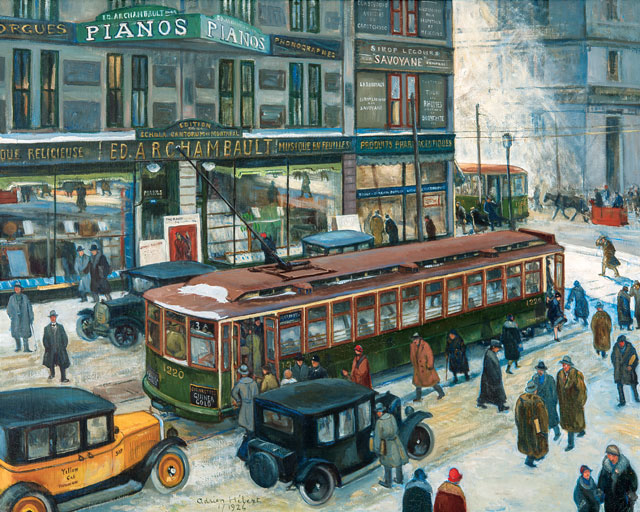The Beaver Hall Group at the MBAM: Montreal in the 1920s, on the Cusp of Modernity by Lina Scarpellini
/ December 1, 2015
Version française...

Adrien Hébert (1890-1967): Saint Catherine Street, 1926, Oil on canvas, 81.5 x 102.2 cm, Archambault family
Photo MMFA, Christine Guest
In the 1920s, Quebec was free of prohibition and enjoying jazz and the Charleston. Montreal’s Beaver Hall Group bore witness to this era and is the subject of a major exhibition at the Montreal Museum of Fine Arts until January 31, 2016.
Comprising around 20 members, mainly Anglophones who had studied at the Art Association of Montreal (today the Montreal Museum of Fine Arts), the group was one of the instigators of modernity in art in Canada during the twenties. Although founded at exactly the same time as Toronto’s Group of Seven, in May 1920, the Beaver Hall Group were very different in their works and their approach.
Instead of painting wild Nordic landscapes, the members chose to mingle portraits, the human form and the natural world, creating humanized landscapes. They painted a great many portraits, among the most remarkable in the history of Canadian art. The ‘roaring twenties’ in Montreal are represented by Henri Hébert’s sculptures of dancers and Prudence Heward’s theatre paintings, while musicians from the United States came to perform in the city’s nightclubs. The exhibition is accompanied by a selection of music from the time, including the song Hello Montreal (Goodbye Broadway).
According to Jacques Des Rochers, art historian, co-curator of the show and co-editor of the publication 1920s Modernism in Montreal, the fact that there were as many women as men in the group was a first in Quebec and Canada, and was more remarkable than the subjects of the paintings. There were ten female painters in the group, including Prudence Heward, Kathleen Morris and Anne Savage.
In 1954, in one of her lectures, Anne Savage revived the memory of the group of which she had been a member. The 1960s reappraised them from a feminist perspective. In 1966 an exhibition dedicated to them showed only works by the women. The anglophone community then came to believe that the group had been comprised only of women. But as Jacques Des Rochers points out, that wasn’t the case, and the exhibition sheds new light on the group as a whole and its art historical importance.
Modern but figurative
Modernity certainly does not mean abstract art. At the entrance of the exhibition the visitor is greeted by Lilias Hewton’s portrait of Miss Audrey Buller, a young, confident-looking woman with short hair and wearing a pretty red dress. The modernity of the 1920s was expressed by lively, contrasting colours, two-dimensionality, originality of composition, connection with reality and choice of subjects. The Immigrants by Prudence Heward is a good example. She also painted female nudes that broke with the aesthetic standards of the time. The works of Adrien Hébert evoke the bustling prosperity of Montreal; his love of the city is reflected in his paintings of St. Denis and St. Catherine Streets.
The portrait was also part of the quest for modernity. Lilias Torrance Newton, considered one of the greatest of Canadian portrait painters, produced nearly 300, including portraits of people who were highly regarded at the time.
Foundation and critical response
Montreal-born A. Y. Jackson was the first chairman of the Beaver Hall Group and also one of the founding members of the Group of Seven. He acted as the liaison between the two groups so they could meet. The Montrealers were frequently invited to exhibit with the Group of Seven and to exhibit abroad, in London and Paris.
The official existence of the group is proved by the lease for 305 Beaver Hall, covering 1920 to 1923, which was found in the city archives. It shows that the group held five shows on the premises. Even if all that remains is an official invitation card, nonetheless the fact that the group was mixed-gender meant it played a vital role in the success of female painters, giving them a chance to forge professional and social connections. Notably, women were excluded from two other important Montreal associations of the era, the Arts Club and the Pen and Pencil Club.
The group, however, wasn’t flavour of the month for everyone. In 1922, S. Morgan Powell, art critic for the Montreal Daily Star, derided “the jazz wall”, the series of portraits that members of the group did for the Art Association’s Spring Exhibition, discerning a tinge of Post-Impressionism. He criticized their “bright colours against astonishing backgrounds”. In Le Devoir Paul Dupré disapproved of the “cacophony” of the canvases, while in defence of the group, Albert Laberge, writing in La Presse, took up the jazz metaphor and likened the bright colours to blaring trumpets.
The exhibition is a chance to reacquaint ourselves with a missing part of Montreal’s artistic heritage and learn about the urban and cultural background that nurtured the creative urges of the Beaver Hall Group.
Translation: Cecilia Grayson
Colours of Jazz: until January 31, 2016 at Montreal Museum of Fine Arts. www.mbam.qc.ca
Version française... | 
